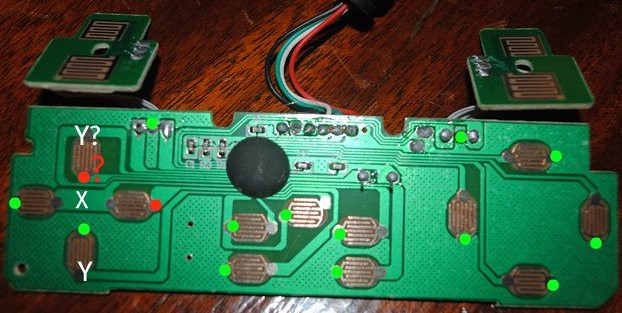Not… quite. First of all, a “second ground” is a misnomer – a second “common” is the more appropriate term (as there can be only one ground, because that effectively means a connection to +0V, connected to the black wire from USB).
Also, thanks to tigermaskchi for bringing in the proper circuitry, and doing teh shoop diagram, for great knowledge! For clarity, the green dots mark the ground pads on each button – however, I’m not sure that we can trust the TURBO/AUTO button markings, as their common line doesn’t connect to a known ground. If you’re not using these buttons, it’s no big deal, but just keep that in mind.
Speaking practically, when you wire the other (non TURBO/AUTO) buttons, you’ll need to tap into one ground to use as a common, and then the unmarked pads on each as the signal wires for each button. Connecting those signal wires to the ground wire will effectively “press” the button, so you can daisy chain off the single ground wire. This should also work for left and down signals, as those need to be shorted to ground to be activated.
Right and up, however, you’ll need to run a wire from both pads directly to both terminals on the switch of the joystick – if you’re using a JLF, this means cutting the common ground trace with a dremel between each switch, and wiring each pair to the now-isolated switch terminals on the PCB. Because you cut the terminals, of course, you’ll also have to bring ground to the down/left buttons individually, but they can be daisy chained instead of brought through via separate wires.
As for shoulder (L/R) buttons, the small solder joints on either side of the green dots in tigermaskchi’s diagram are going to be your signal wires – you can just wire them and figure out which is which later, or you can try to visually follow which line goes to which button (or even better, just use a multimeter). Feel free to remove/discard the short 3-signal ribbon cables, and the small daughterboards with the actual contacts on them, as they’ll serve no purpose.




 buttons and box are the only things left.
buttons and box are the only things left.